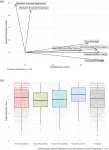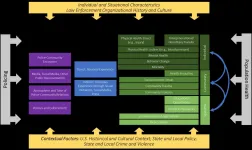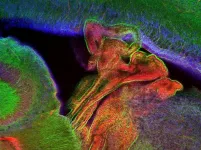Remote control for plants
2021-07-09
(Press-News.org) Plants have microscopically small pores on the surface of their leaves, the stomata. With their help, they regulate the influx of carbon dioxide for photosynthesis. They also use the stomata to prevent the loss of too much water and withering away during drought.
The stomatal pores are surrounded by two guard cells. If the internal pressure of these cells drops, they slacken and close the pore. If the pressure rises, the cells move apart and the pore widens.
The stomatal movements are thus regulated by the guard cells. Signalling pathways in these cells are so complex that it is difficult for humans to intervene with them directly. However, researchers of the Julius-Maximilians-Universität (JMU) Würzburg in Bavaria, Germany, nevertheless found a way to control the movements of stomata remotely - using light pulses.
Light-sensitive protein from algae used
The researchers succeeded in doing this by introducing a light-sensitive switch into the guard cells of tobacco plants. This technology was adopted from optogenetics. It has been successfully exploited in animal cells, but the application in plant cells it is still in its infancy.
The team led by JMU biophysicist and guard cell expert Professor Rainer Hedrich describes their approach in the prestigious scientific journal Science Advances. JMU researchers Shouguang Huang (first author), Kai Konrad and Rob Roelfsema were significantly involved.
The group used a light-sensitive protein from the alga Guillardia theta as a light switch, namely the anion channel ACR1 from the group of channelrhodopsins. In response to light pulses, the switch ensures that chloride flows out of the guard cells and potassium follows. The guard cells lose internal pressure, slacken and the pore closes within 15 minutes. "The light pulse is like a remote control for the movement of the stomata," says Hedrich.
Anion channel hypothesis confirmed
"By exposing ACR1 to light, we have bridged the cell's own signalling chain, thus proving the hypothesis that the opening of anion channels is essential and sufficient for stomatal closure," Hedrich summarises the results of the study. The exposure to light had almost completely prevented the transpiration of the plants.
With this knowledge, it is now possible to cultivate plants with an increased number of anion channels in the guard cells. Plants equipped in this way should close their stomata more quickly in response to approaching heat waves and thus be better able to cope with periods of drought.
"Plant anion channels are activated during stress; this process is dependent on calcium. In a follow up optogenetics project, we want to use calcium-conducting channelrhodopsins to specifically allow calcium to flow into the guard cells cell through exposure to light and to understand the mechanism of anion channel activation in detail," Hedrich outlines the upcoming goals of his research.
Basic scientific research can also benefit from the results from Würzburg: "Our new optogenetic tool has enormous potential for research," says the JMU professor. "With it, we can gain new insights into how plants regulate their water consumption and how carbon dioxide fixation and stomatal movements are coupled."
INFORMATION:
ELSE PRESS RELEASES FROM THIS DATE:
2021-07-09
A research team co-led by UCL (University College London) has solved a decades-old mystery as to how Jupiter produces a spectacular burst of X-rays every few minutes.
The X-rays are part of Jupiter's aurora - bursts of visible and invisible light that occur when charged particles interact with the planet's atmosphere. A similar phenomenon occurs on Earth, creating the northern lights, but Jupiter's is much more powerful, releasing hundreds of gigawatts of energy, enough to briefly power all of human civilisation*.
In a new study, published in Science Advances, researchers combined close-up observations of Jupiter's environment by NASA's satellite Juno, which is currently orbiting the planet, with simultaneous X-ray ...
2021-07-09
Two factors that play a key role in climate change - increased climate warming and elevated ozone levels - appear to have detrimental effects on soybean plant roots, their relationship with symbiotic microorganisms in the soil and the ways the plants sequester carbon.
The results, published in the July 9 edition of Science Advances, show few changes to the plant shoots aboveground but some distressing results underground, including an increased inability to hold carbon that instead gets released into the atmosphere as a greenhouse gas.
North Carolina State University researchers examined the interplay of warming and increased ozone levels with certain important underground organisms - arbuscular ...
2021-07-09
A survey offered to transgender and nonbinary people across six continents and in thirteen languages shows that during the first months of the COVID-19 pandemic, many faced reduced access to gender-affirming resources, and this reduction was linked to poorer mental health. Brooke Jarrett of the Johns Hopkins Bloomberg School of Public Health, Baltimore, Maryland, and colleagues present the findings in the open-access journal PLOS ONE on July 9.
Gender-affirming resources, which can include health care such as surgery and/or hormone therapy as well as gender affirming services and products --are well-known to significantly ...
2021-07-09
Trust in science - but not trust in politicians or the media - significantly raises support across US racial groups for COVID-19 social distancing.
INFORMATION:
Article Title: The role of race and scientific trust on support for COVID-19 social distancing measures in the United States
Funding: The authors received no specific funding for this work.
Competing Interests: The authors have declared that no competing interests exist.
Article URL: https://journals.plos.org/plosone/article?id=10.1371/journal.pone.0254127
...
2021-07-09
A specific police action, an arrest or a shooting, has an immediate and direct effect on the individuals involved, but how far and wide do the reverberations of that action spread through the community? What are the health consequences for a specific, though not necessarily geographically defined, population?
The authors of a new UW-led study looking into these questions write that because law enforcement directly interacts with a large number of people, "policing may be a conspicuous yet not-well understood driver of population health."
Understanding how law enforcement impacts the mental, physical, social and structural health and wellbeing of a community is a complex challenge, involving many academic and research ...
2021-07-09
Meningitis is associated with high mortality and frequently causes severe sequelae. Newborn infants are particularly susceptible to this type of infection; they develop meningitis 30 times more often than the general population. Group B streptococcus (GBS) bacteria are the most common cause of neonatal meningitis, but they are rarely responsible for disease in adults. Scientists from the Institut Pasteur, in collaboration with Inserm, Université de Paris and Necker-Enfants Malades Hospital (AP-HP), set out to explain neonatal susceptibility to GBS meningitis. In a mouse model, they demonstrated that the immaturity of both the gut microbiota and epithelial barriers such as the gut and choroid plexus play a role in the susceptibility of newborn infants to bacterial meningitis caused by ...
2021-07-09
The Delta variant was detected for the first time in India in October 2020 and has since spread throughout the world. It is now dominant in many countries and regions (India, the UK, Portugal, Russia, etc.) and is predicted to be the most prevalent variant in Europe within weeks or months. Epidemiological studies have shown that the Delta variant is more transmissible than other variants. Scientists from the Institut Pasteur (CNRS joint unit), in collaboration with Hôpital Européen Georges Pompidou (part of the Paris Public Hospital Network or AP-HP), Orléans Regional Hospital and Strasbourg University Hospital, studied the sensitivity of the Delta variant ...
2021-07-09
To enable tissue renewal, human tissues constantly eliminate millions of cells, without jeopardizing tissue integrity, form and connectivity. The mechanisms involved in maintaining this integrity remain unknown. Scientists from the Institut Pasteur and the CNRS today revealed a new process which allows eliminated cells to temporarily protect their neighbors from cell death, thereby maintaining tissue integrity. This protective mechanism is vital, and if disrupted can lead to a temporary loss of connectivity. The scientists observed that when the mechanism is deactivated, the simultaneous elimination of ...
2021-07-09
New Brunswick, N.J. (July 9, 2021) -- A massive volcanic eruption in Indonesia about 74,000 years ago likely caused severe climate disruption in many areas of the globe, but early human populations were sheltered from the worst effects, according to a Rutgers-led study.
The findings appear in the journal PNAS.
The eruption of the Toba volcano was the largest volcanic eruption in the past two million years, but its impacts on climate and human evolution have been unclear. Resolving this debate is important for understanding environmental changes during a key interval in human evolution.
"We were able to use a large number of climate model simulations to resolve what seemed like a paradox," said lead author Benjamin Black, an assistant professor in the Department ...
2021-07-09
Changing climate patterns have left millions of people vulnerable to weather extremes. As temperature fluctuations become more commonplace around the world, conventional power-guzzling cooling and heating systems need a more innovative, energy-efficient alternative, and in turn, lessen the burden on already struggling power grids.
In a new study, researchers at Texas A&M University have created novel 3D printable phase-change material (PCM) composites that can regulate ambient temperatures inside buildings using a simpler and cost-effective manufacturing process. Furthermore, these composites can be added to building materials, like paint, or 3D printed as decorative home accents to seamlessly integrate into different indoor environments.
"The ability to integrate phase-change materials ...
LAST 30 PRESS RELEASES:
[Press-News.org] Remote control for plants





